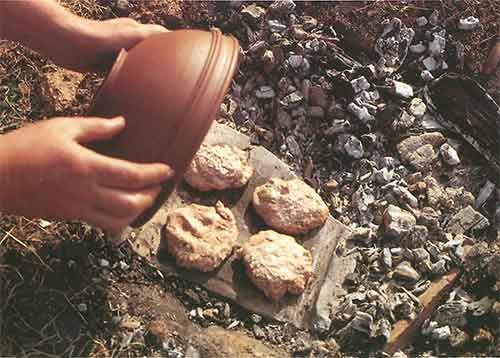Military Bread
(Panis Militaris)
(Panis Militaris)

Panis Militaris being made with a clibanus which was a portable oven or
mould,
broader at the bottom than the top.
Pliny the Elder: Natural History 18.67, Cato the Elder: On Agriculture 83
Hard tack military bread made from emmer wheat flour, water, and salt. The Roman army's practice of having its soldiers grind, knead and cook their own bread had many advantages — but it also could lead to problems. In the first place, bread spoils in a relatively short time, after about four or five days in warm weather, and about a week in colder climates. The cooking of bread required building fires, which could reveal the army's presence to the enemy. In addition, there were circumstances in which the army had to move rapidly, without bringing mills or stopping to gather firewood.
The major difference between the normal campaign ration and the pre-prepared “iron ration” (to use a modern term) is the substitution of biscuit for bread or puls made on the spot from grain. Biscuit can keep a month or longer, is lighter than unground grain and requires no cooking. Re-baking bread into biscuit or hardtack also reduces its weight. When rebaked into biscuit, 850 grams of bread produce around 650 grams of biscuit, but since the main elements lost are water and air, there is little reduction in nutritive value. In Late Latin hardtack was called buccelatum ( derived from bucella, “mouthful”), and this may be what Pliny calls “old or ship's bread” (vetus aut nauticus panis). Most likely, such hardtack was prepared at the same level as bread, i.e. by the contubernium. The iron ration also may also have replaced fresh or pickled elements of the diet with dried versions — which are lighter and less bulky. The expression cibaria cocta, sometimes abbreviated to cibum, refers to such rations, prepared in bulk before a march.
Cato the elder, who has also participated in a victorious military campaign in Spain, explains how to bake bread under a "clibanus" (pottery in the shape of a bell). Moreover, we find evidence proving that at that time both Romans and Carthaginians used clibanus as portable ovens like the type described by Cato. Etruscan models dated back to the 5th century BC show that this type of portable oven was already used in Italy for a long time. Ideally suited for baking military bread, it is also very easy to transport and use. The clibanus is thus the ideal instrument to cook bread in campaign.
Original recipe:
Translation: Recipe for kneaded bread: Wash your hands and a bowl thoroughly. Pour meal into the bowl, add water gradually, and knead thoroughly. When it is well kneaded, roll out and bake under a crock.
Ingredients
- 2.2 lbs emmer flour
- 4 cups water
- salt
Preparation
- Place a brick, flat rock, or roofing tile in a fire that has been reduced to coals and cover with coals and hot ashes.
- Add flour and salt to water to make a dough of a kneadable consistency.
- Clear the tile or heating surface of coals and ashes and flatten handful pieces of dough on it to about a palm's thickness and breadth.
- Cover with a clay pot or patera to trap the heat and bake to the consistency desired.




















